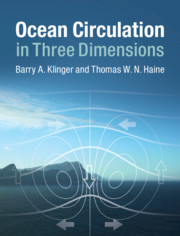3653 results in ebooks in fluid mechanics
Plates
-
- Book:
- Ocean Circulation in Three Dimensions
- Published online:
- 11 March 2019
- Print publication:
- 14 March 2019, pp 1-4
-
- Chapter
- Export citation

Ocean Circulation in Three Dimensions
-
- Published online:
- 11 March 2019
- Print publication:
- 14 March 2019
4 - Regression and Model Selection
- from Part II - Machine Learning and Data Analysis
-
- Book:
- Data-Driven Science and Engineering
- Published online:
- 15 February 2019
- Print publication:
- 28 February 2019, pp 117-153
-
- Chapter
- Export citation
5 - Clustering and Classification
- from Part II - Machine Learning and Data Analysis
-
- Book:
- Data-Driven Science and Engineering
- Published online:
- 15 February 2019
- Print publication:
- 28 February 2019, pp 154-194
-
- Chapter
- Export citation
Part IV - Reduced Order Models
-
- Book:
- Data-Driven Science and Engineering
- Published online:
- 15 February 2019
- Print publication:
- 28 February 2019, pp 373-374
-
- Chapter
- Export citation
Frontmatter
-
- Book:
- Data-Driven Science and Engineering
- Published online:
- 15 February 2019
- Print publication:
- 28 February 2019, pp i-iv
-
- Chapter
- Export citation
11 - Reduced Order Models (ROMs)
- from Part IV - Reduced Order Models
-
- Book:
- Data-Driven Science and Engineering
- Published online:
- 15 February 2019
- Print publication:
- 28 February 2019, pp 375-402
-
- Chapter
- Export citation
Glossary
-
- Book:
- Data-Driven Science and Engineering
- Published online:
- 15 February 2019
- Print publication:
- 28 February 2019, pp 436-442
-
- Chapter
- Export citation
12 - Interpolation for Parametric ROMs
- from Part IV - Reduced Order Models
-
- Book:
- Data-Driven Science and Engineering
- Published online:
- 15 February 2019
- Print publication:
- 28 February 2019, pp 403-435
-
- Chapter
- Export citation
Part III - Dynamics and Control
-
- Book:
- Data-Driven Science and Engineering
- Published online:
- 15 February 2019
- Print publication:
- 28 February 2019, pp 227-228
-
- Chapter
- Export citation
Index
-
- Book:
- Data-Driven Science and Engineering
- Published online:
- 15 February 2019
- Print publication:
- 28 February 2019, pp 471-472
-
- Chapter
- Export citation
3 - Sparsity and Compressed Sensing
- from Part I - Dimensionality Reduction and Transforms
-
- Book:
- Data-Driven Science and Engineering
- Published online:
- 15 February 2019
- Print publication:
- 28 February 2019, pp 84-114
-
- Chapter
- Export citation
7 - Data-Driven Dynamical Systems
- from Part III - Dynamics and Control
-
- Book:
- Data-Driven Science and Engineering
- Published online:
- 15 February 2019
- Print publication:
- 28 February 2019, pp 229-275
-
- Chapter
- Export citation
10 - Data-Driven Control
- from Part III - Dynamics and Control
-
- Book:
- Data-Driven Science and Engineering
- Published online:
- 15 February 2019
- Print publication:
- 28 February 2019, pp 345-372
-
- Chapter
- Export citation
Bibliography
-
- Book:
- Data-Driven Science and Engineering
- Published online:
- 15 February 2019
- Print publication:
- 28 February 2019, pp 443-470
-
- Chapter
- Export citation
Preface
-
- Book:
- Data-Driven Science and Engineering
- Published online:
- 15 February 2019
- Print publication:
- 28 February 2019, pp ix-xii
-
- Chapter
- Export citation
9 - Balanced Models for Control
- from Part III - Dynamics and Control
-
- Book:
- Data-Driven Science and Engineering
- Published online:
- 15 February 2019
- Print publication:
- 28 February 2019, pp 321-344
-
- Chapter
- Export citation
2 - Fourier and Wavelet Transforms
- from Part I - Dimensionality Reduction and Transforms
-
- Book:
- Data-Driven Science and Engineering
- Published online:
- 15 February 2019
- Print publication:
- 28 February 2019, pp 47-83
-
- Chapter
- Export citation
6 - Neural Networks and Deep Learning
- from Part II - Machine Learning and Data Analysis
-
- Book:
- Data-Driven Science and Engineering
- Published online:
- 15 February 2019
- Print publication:
- 28 February 2019, pp 195-226
-
- Chapter
- Export citation
Part II - Machine Learning and Data Analysis
-
- Book:
- Data-Driven Science and Engineering
- Published online:
- 15 February 2019
- Print publication:
- 28 February 2019, pp 115-116
-
- Chapter
- Export citation
